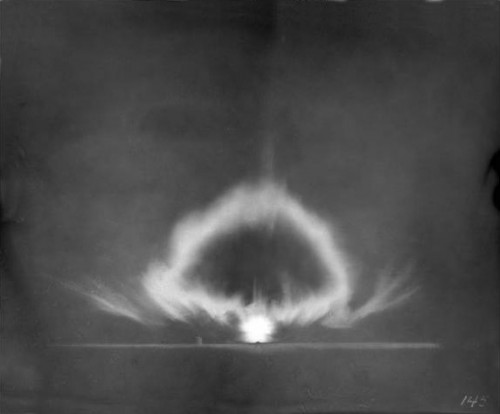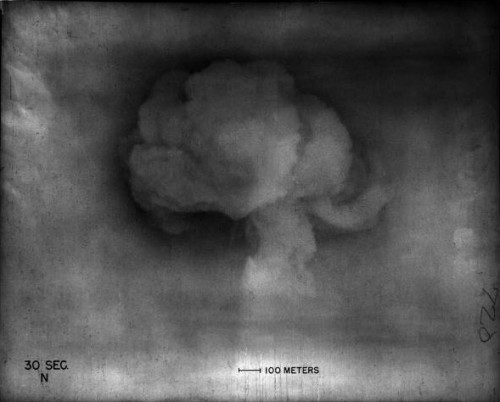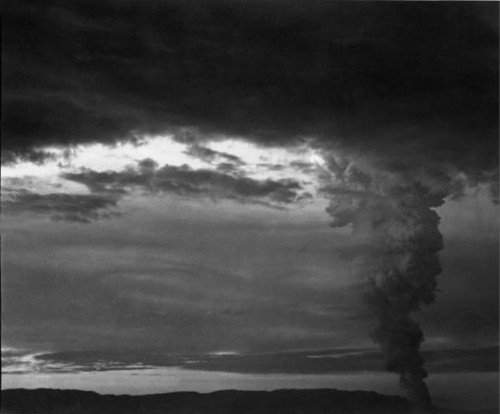The mushroom cloud has long been the symbol of what it meant to set off a nuclear weapon. But, as Spencer Weart noted in his Nuclear Fear (I haven’t checked to see if it is in the new edition, The Rise of Nuclear Fear, yet), it wasn’t always so, nor necessarily so. There are other words in English you could describe such a cloud, though “mushroom” has nice symbolic connotations. But more to the point I want to make here, you don’t necessarily have to focus on the cloud in its most mushroom-y stage. There are lots of ways to photograph a nuclear explosion, and the ideal mushroom cloud shape represents just one particular point in time in the evolution of the nuclear effects.
Case in point, the “standard” image of the “Trinity” shot (July 16, 1945), is not of a mushroom cloud, but as a blobby fireball, milliseconds after detonation: 1

It’s kind of curious, isn’t it, that these sorts of images are the most common? I haven’t traced out the whole story here, but the obvious reason for this is that these are the images that were first distributed about the test in the wake of the bombings of Hiroshima and Nagasaki. (There’s one of the “fireball” photos inside the Princeton University Press edition of the Smyth Report, for example.)
Why the fireball and not the cloud? One might be tempted to say it has something to do with wanting to underplay the fallout, but of course they did distribute photos of the Hiroshima and Nagasaki mushroom clouds. I suspect that the reason isn’t terribly deep — that, perhaps, whomever chose the photos was more impressed by the massive fireball with its uncanny spherical shape than they were by a mere mushroom cloud, which, without a sense of scale, is indistinguishable from many other large explosions. But this is just speculation. I’ve never found much documentation on the release of the “Trinity” photos — just a memo from a year later (the summer of 1946) which said, interestingly, that the decision to declassify all of the tiny-time scale “Trinity” photos (like the ones linked above) was made after consultation with none other than Klaus Fuchs.
The other common photo of “Trinity” is the Jack Aeby photo, perhaps most famous these days as being the cover of Richard Rhodes’ Making of the Atomic Bomb. It is later than the millisecond photos, obviously, but is still very early in the cloud formation.
Below are some alternative views of “Trinity,” from Los Alamos National Laboratory’s archives. They show considerably different stages of the cloud development, and are pretty interesting images for that reason:
I find all of these ones to be much more ominous than either the fireball or the Aeby photos — they are dark, they are smokey, they are not friendly. The last one in particular looks like something ancient and terrible. Which arguably is as correct an interpretation of the “Trinity” test as the more common narrative about inspiring achievement.
- All of these images come from Los Alamos National Laboratory; their file names reflect their index numbers within the LANL system.[↩]






It just struck me that the 16ms photo at Wikipedia looks a lot like the S.E. Johnson Scrubbing Bubbles ™! Which makes a certain kind of twisted sense…
Whoops – image tags aren’t allowed!
So go here to see what I’m talking about.
John: I’ve always thought it looked bubble-like as well. For me the sound-effect that felt like it accompanied that one was always sort of a fantastical “GLORP.”
I just got Nuclear Fear out of the library and now you’re telling me there’s a Son of Nuclear Fear? How am I going to write anything if the literature won’t let me catch up?
It is worth noting that those blobby fireball pictures (published in Life) enabled G. I. Taylor to estimate the yield: http://en.wikipedia.org/wiki/Nuclear_weapon_yield#Calculating_yields_and_controversy
Indeed! This was why, in 1946, they weighed whether any more sensitive information could be discerned from those photos, before releasing more of them. (It should be noted that the rough estimate of 20,000 tons of TNT had already been released publicly, so estimating the yield was not, at this point, any great secret.)
Fuchs apparently was assigned to look in depth at the “early shape of the radius-time curve” after discussion of the matter with Bethe and Peierls. A line from the July 1946 memo that authorizes this declassification that I find cryptic: “Part of the basis of this decision lay in the relatively great mass of tower material near the gadget.” If anybody wants to hazard a guess as to what that really means, I’m all ears!
Looking at the Wikipedia article about Taylor’s method, a key assumption is that the bomb’s energy goes into heating up the air. Which is a reasonable assumption if the bomb is dropped and explodes well above the ground. But the Trinity device was on top of a shot tower inside a cab. Which went away during the explosion. So some of the energy of the bomb went into vaporizing the shot tower (obviously the bomb itself also vaporizes, but its mass is relatively small in the overall picture). If the shot tower was of “relatively great mass” then the heating up the air estimate will be too low.
Presumably Fuchs and company figured that potential adversaries wouldn’t know how massive the shot tower was – it would be an interesting exercise to see if available pictures let one estimate the mass of steel in the tower and cab. There is that picture of Groves and Oppemheimer standing at the base of what is left of the shot tower, which might let one figure out the relative scale of other pictures of the tower.
Which leads to an interesting historical question – During the early atomic age did the US want the rest of the world to under- or over- estimate the yield of our weapons? Maybe just maintaining uncertainty was good enough.
John: That’s super interesting.
Just as an aside, the Groves/Oppenheimer photos at the Trinity base site were done in early September 1945, when they arranged for a press “safari” out to the site (as they called it).
There are a few ways I can think of to address the latter question. I’ll try to address this in a future post, as it is a really interesting topic, one which has really interesting overlaps with Civil Defense issues and the question of how much information you can deduce about the early stockpile size from such numbers. Briefly, though, I think their main concern with giving out accurate yields came from the possibility of confirming/verifying Soviet attempts at monitoring mixed with their attitudes towards what they felt the domestic (US) population ought to know, which is not quite the same thing as caring about over- or under-estimation. In general the sorts of yields that were openly discussed were considerably under whatever the present stockpile was, though.
The US didn’t even want our allies to know nuclear secrets and that almost got people killed. We used lithium 6 and 7 mixed together to make the first fusion boosted weapon and didn’t correctly calculate the yield because it was incorrectly assumed that lithium 7 wouldn’t fuse under those conditions. Making pure lithium 6 was simply too difficult and costly.
We didn’t tell the British this. Their first fusion boost test shot produced 40% more yield than expected because they made the same mistake [and some of their observers were standing closer than they should have]. Hence the joke “Almost only counts in horseshoes, hand grenades and hydrogen bombs.”
Photos are unique! Thanks you!!! I the collector of nuclear tests, have many photos, films on nuclear tests. Such I has seen for the first time!
Alex Wellerstein, you will have other new photos of nuclear explosions of the USA? (mushroom cloud, nevada and other) in normal quality?
Spasibo, Alexander! I have a small set of other test photos that (I at least) have not widely seen. I’ll post some of them over time. One of my favorites is the Greenhouse Item shot I posted here, which has wonderful colors.
You have written “thanks” in Russian. You Russian?) We can communicate in private, via an e-mail? please. your e-mail?
I can read a little Russian, with a dictionary in hand, and can say very basic things. But I don’t speak or write it with any proficiency. My e-mail is here, at the very end (the Gmail address); please feel free to e-mail me in Russian and I will try to make sense of it (or ask a friend or two to help). But I can only really reply in English, myself.
I send you letter… on wellerstein (at) gmail (dot) com
I was wondering if they images are available in higher resolution on LANL’s website, or if you have copies of them that are of a higher resolution?
Sincerely,
Matt C.
You can get higher res copies from LANL. TR-145 is online on their website at high res, but the others aren’t. But if you e-mail Alan Carr (abcarr@lanl.gov) with a subject line of “Request high-res image for” plus the image identification number (e.g. TR-145 — check the file names for whatever I posted), he will (if you are very nice) send you the high-res versions of whichever you want. The lab has always been very helpful for me in tracking down high-res copies of the old Trinity images. (The ones I’ve shown above come from a massive catalog of all of the Trinity images, a copy of which John Coster-Mullen sent me some time ago.)
hello alex! My e-mail nuclear_test@mail.ru no spam. answer me)
[…] and red scheme. (Life magazine also featured an Ivy Mike image on the cover that week, but chose the fireball instead of the […]
[…] and there’s a pretty standard visual vocabulary for how those look. (Something I’ve touched on before.) Personally I find it a little easy to get desensitized to mushroom clouds after awhile. They all […]
[…] Ah, that Beria! To appropriate a line from Solzhenitsyn’s Gulag Archipelago (which is now, very recently, available in Kindle format, which is really an ideal way to read this amazing but hefty book): “This ought to be shown in a film comedy, but they wouldn’t allow it: there is nothing funny in our life; everything funny takes place in the West!” Michael also notes that another physicist had been asked by Beria to be Kurchatov’s “understudy,” with the implicit understanding that he would take over if Kurchatov failed and was shot. Oy. The mushroom cloud from “First Lightning.” Darker and more ominous than your standard “Trinity” photographs. […]
For What It’s Worth,
I’m 65 years old, and grew up three blocks from L.A. International Airport. Which is like living in the black ring of the bulls-eye painted on LA- what with Douglas, North American, Rockwell, Hughes, Rocket-dyne, Northrup, General Dynamics, Motorola, TRW, etx. and the thousands of small job shops supporting the US Aerospace and Defense industries within a five mile radius. I don’t know what you do or don’t know, but there were no secrets about the A-Bomb. Just look at the dates of information and material that was released. There was no conspiracy about suppressing information about fallout from the “mushroom clouds”,or it’s lethality in general, or surviving it in particular. Between Linus Pauling, Robert Oppenhemier, Teller, Bertrand Russell, and the scores of Manhattan Project scientists, the full implication of nuclear war was well known, and well documented, and I might add, also, thoroughly investigated by J. Edgar Hoover, the FBI, and HUAC. I had nightmares about the bomb until I saw Stanley Kubrick’s Dr. Strangelove. But to go to your issue, on that morning in Alamogordo, there was no shortage of motion picture cameras; they were shooting from 16 and 32 Kilometers from point of event. The photos in series you reference were not motion photography- they were still cameras- literally pin hole cameras, with one exposure per camera. Some were heavily fogged from radiation, some disabled by blast, gamma, and emf. The few images of the “cloud” rising in the sky is the result of the brightness of the cloud in the pre-dawn darkness, film speed, and exposure criteria. It was in predawn darkness that the event occurred, and given the exposure latitude of film and aperture, distance and altitude, whether those columnar clouds were recorded, or not, I doubt that they would have been suppressed as much as they were very poor quality images.
Thanks, J.E., that’s interesting. You are definitely correct that some of these (especially the solarized one) are pin-hole cameras, though some of the others look like automatics.
As for “suppression,” I doubt they were kept “secret” for any classification reason, but were definitely not passed out as part of the press kits, because of their quality, and because the Manhattan Project at that point had a very tightly coordinated public relations front it was trying to put out there. The fact that there were barely any photographs of the cloud itself from Trinity has always been odd to me — it’s one of the few tests where the “public” photos focus almost exclusively on the fireball.
[…] the cloud was spread-out and looming: Alex Wellerstein calls it dark and smokey (he has pictures here and […]
The bomb did vaporized the steel tower but how could the base of the tower isn’t vaporized and actually it’s still there until now?
The bomb vaporized the tower but exposed the heavy-set concrete base struts (four of them). I don’t know if they are still there now. They were not what I would call undamaged.